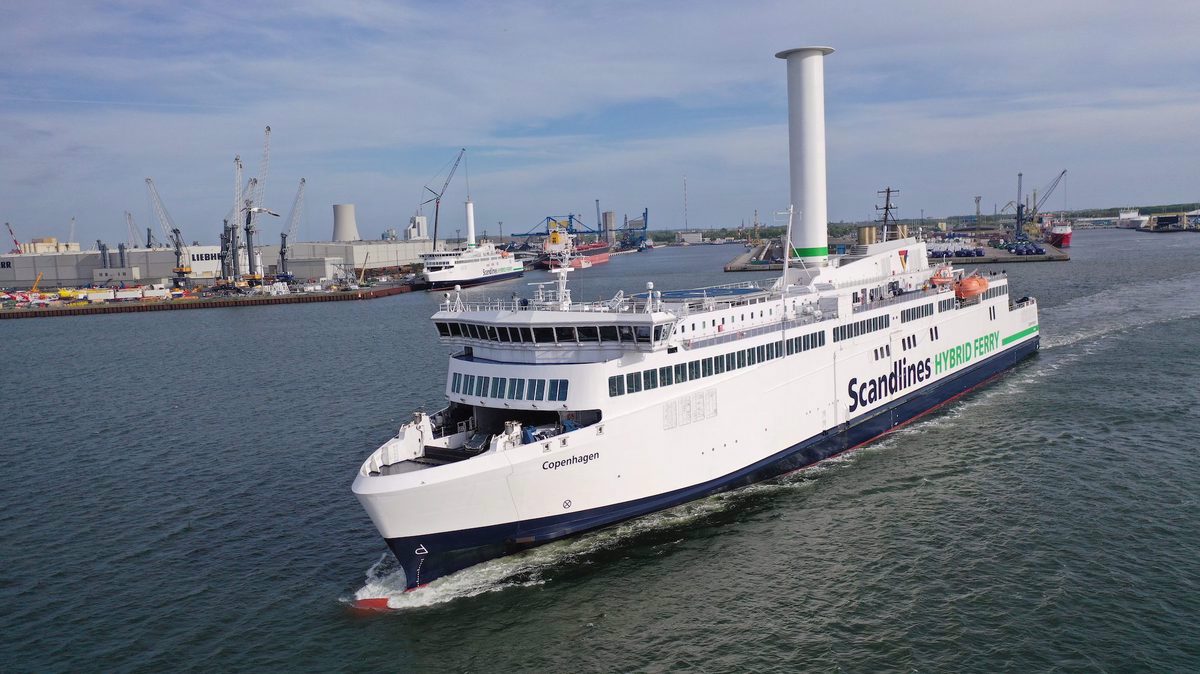The Week in Alternative Fuels
Here are some of the key developments in alternative bunker fuels from the past week.
 PHOTO: Scandlines hybrid ferry with Norsepower rotor sails installed. Scandlines
PHOTO: Scandlines hybrid ferry with Norsepower rotor sails installed. Scandlines
The European Parliament's Environment Committee voted for a more extensive emissions regulations agenda that sets out to include shipping emissions in the EU Emissions Trading System (EU ETS) for the first time.
The EU announced it is putting up around €210 billion ($220 billion) in funds to phase out Russian oil and gas by 2027, with around €10 billion ($10.5 billion) going to develop oil and LNG infrastructure. The remaining 95% of the package, known as REPowerEU, will go to renewables, including hydrogen infrastructure, electric power grids, heat pumps and other energy saving measures.
A new study commissioned by the International Chamber of Shipping (ICS) has found that a complete decarbonisation of just shipping will require twice as much renewable electricity as today's total capacity across sectors.
Chile’s abundant access to renewable energy sources makes it ideally placed to become a major hydrogen producer and exporter to Europe and other regions, the Port of Rotterdam Authority says.
Norwegian shipping firm Golden Energy Offshore has entered into a knowledge-sharing partnership with hydrogen company Gen2 Energy to identify suitable hydrogen bunkering locations for its fleet.
Dutch biofuel company GoodFuels has partnered with Japanese trading firm ITOCHU Corporation to build out a marine biofuel supply chain across Singapore, Japan, and Asia-Pacific.
Japanese shipping company Kawasaki Kisen Kaisha (K Line) has received approvals in principle (AIP) from classification society ClassNK for its designs for LNG-fuelled and battery-powered vessels.
Dutch LNG supplier Titan LNG has struck a deal with Brittany Ferries to supply LNG and liquified biomethane (LBM) to two of its Ro-Pax vessels in the English Channel.
Shipping company Louis Dreyfus Armateurs (LDA) aims to improve fuel efficiency and reduce emissions with three suction sail systems installed by Spanish rigid sail technology company Bound4blue on one of its vessel next year.
Here are the top five stories in alternative fuels this week:
EU announces massive spending to wean off Russian fossil fuels
European Commission president Ursula von der Leyen announced that EU is putting up around €210 billion ($220 billion) in funds to phase out Russian oil and gas by 2027.
Around 95% of the funds will be allocated for renewable energy, including hydrogen infrastructure, electric power grids, heat pumps and other energy saving measures.
The group plans to speed transition towards cleaner fuels by massive spending to develop alternative fuel technologies and infrastructure.
The block seeks to increase its energy security by procuring energy products jointly, so member states don’t compete unnecessarily with each other.
EU lawmakers vote to expand ETS to cover shipping
Under the proposed EU ETS plan, half of emissions from voyages to and from EU countries will be included between 2024-2026, before this is expanded to 100% from 2027.
62 of 87 Members of the European Parliament (MEPs) voted in favour of revising the ETS with more far-reaching mandates for shipping.
Three-quarters of the revenues generated from auctioning out shipping emission allowances will go towards an Ocean Fund dedicated to support shipping’s transition to low-carbon energy uptake.
The revised ETS needs to go through a vote at the upcoming plenary session of the European Parliament on 6-9 June and then to be negotiated with EU member states.
Chile could produce the world’s cheapest green hydrogen – Port of Rotterdam
Rotterdam recently concluded a feasibility study on Chilean hydrogen production, exploring a 200-500 MW-capacity green hydrogen production project called TANGO.
The hydrogen will be converted to ammonia and shipped to Europe. The partners target an initial flow of 127,000 mt/year from 2027, before eventually ramping that volume up to 430,000 mt/year.
Other partners are Chilean energy company GASCO, Uruguayan hydrogen firm HyNewGen, Irish chemical company Linde and Dutch storage tank operator Vopak.
Chile has been considered a strategic location for production of green fuels as it can tap into its abundant sources of renewable energy, especially solar and wind power.
Last week, Rotterdam and a large group of exporting countries and other companies announced plans to supply northwest Europe with 4.6 million mt/year of hydrogen by 2030 through local production and imports.
Global renewable energy capacity must double for shipping to get a chance at net-zero– study
A new study commissioned by the International Chamber of Shipping (ICS) has found that a complete decarbonisation of shipping will require about 3,000 TWh of renewably sourced electricity.
Professor Stefan Ulreich of Germany’s University of Applied Sciences, the study’s author, argues that shipping must be included in international decarbonisation targets if shipping is to have a chance at decarbonising fully.
The study estimates that ships will carry about half of the world’s net-zero fuels by 2050 and goes on to argue that they should have access to consume these fuels. Competition for net-zero fuels is expected to intensify as we move closer to global emissions targets over the next decades.
This presents a big opportunity for renewable electricity producers, especially for certain countries in the Global South that are highlighted as places with great potential.
Latin American and African countries with abundant access to renewable energy sources like solar and wind are estimated to potentially have a fifth lower production costs for net-zero fuels, the study finds.
GoodFuels, ITOCHU to grow marine bio-bunker supply chain in Asia-Pacific
The duo will first focus on supplying marine biofuels to Singaporean waterways and the Strait of Malacca. They aim to scale up deliveries to the wider Asia-Pacific region in the second phase of the partnership.
GoodFuels will be responsible for sourcing, production, technical expertise and marketing, while ITOCHU will take care of logistics, blending, and distribution.
It claims that its biofuel can reduce well-to-exhaust carbon dioxide emissions by 80-90% compared to conventional bunker fuels.





